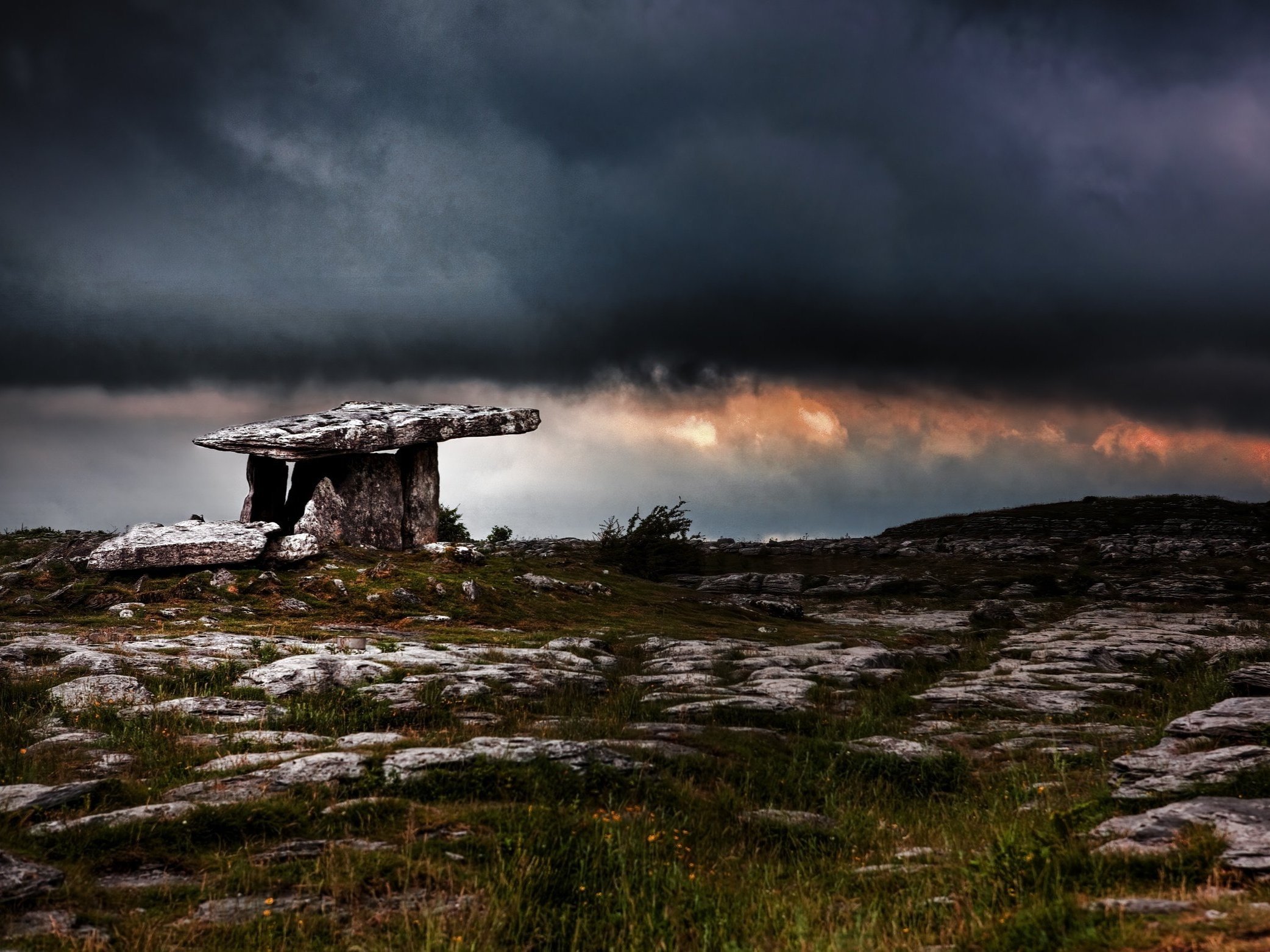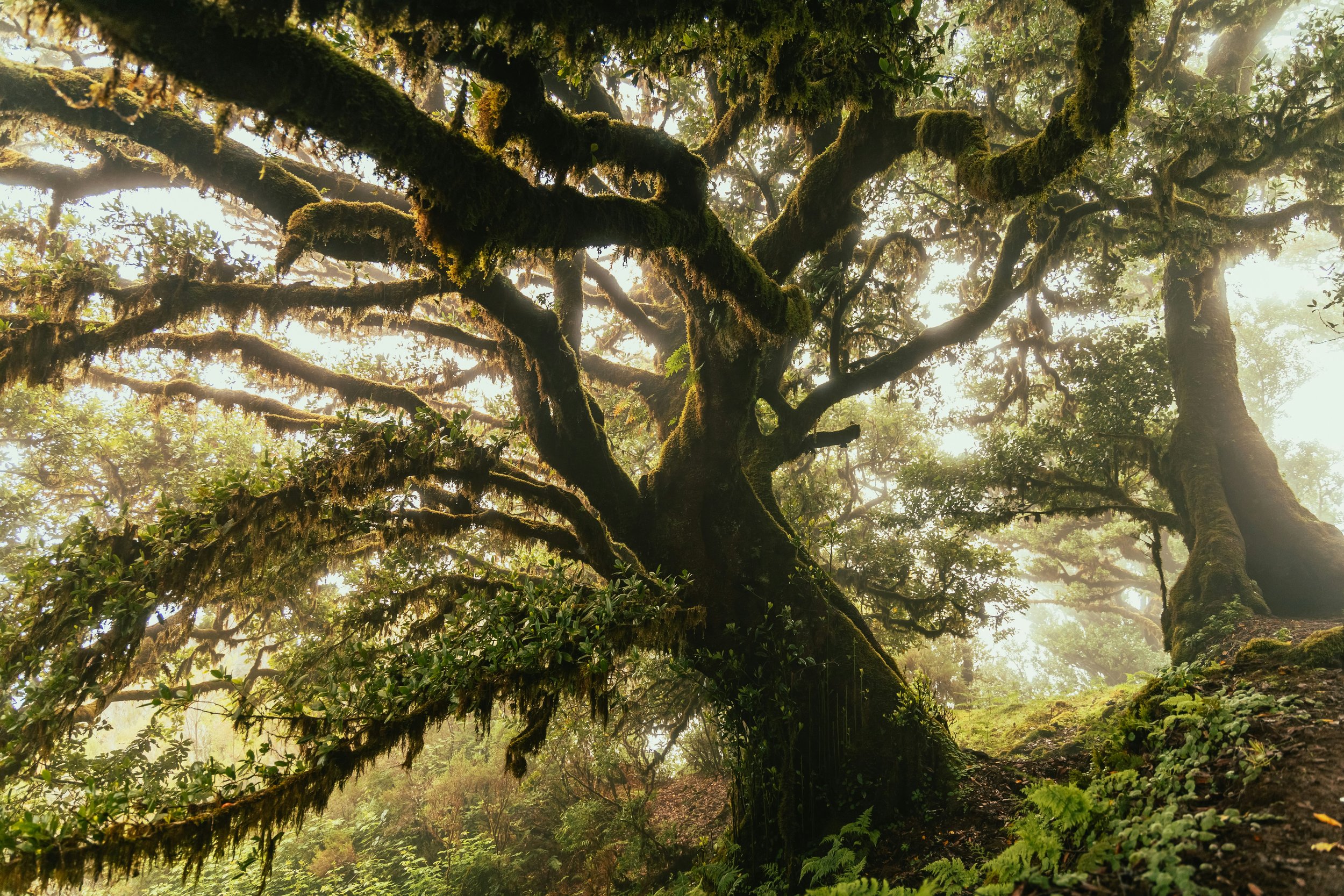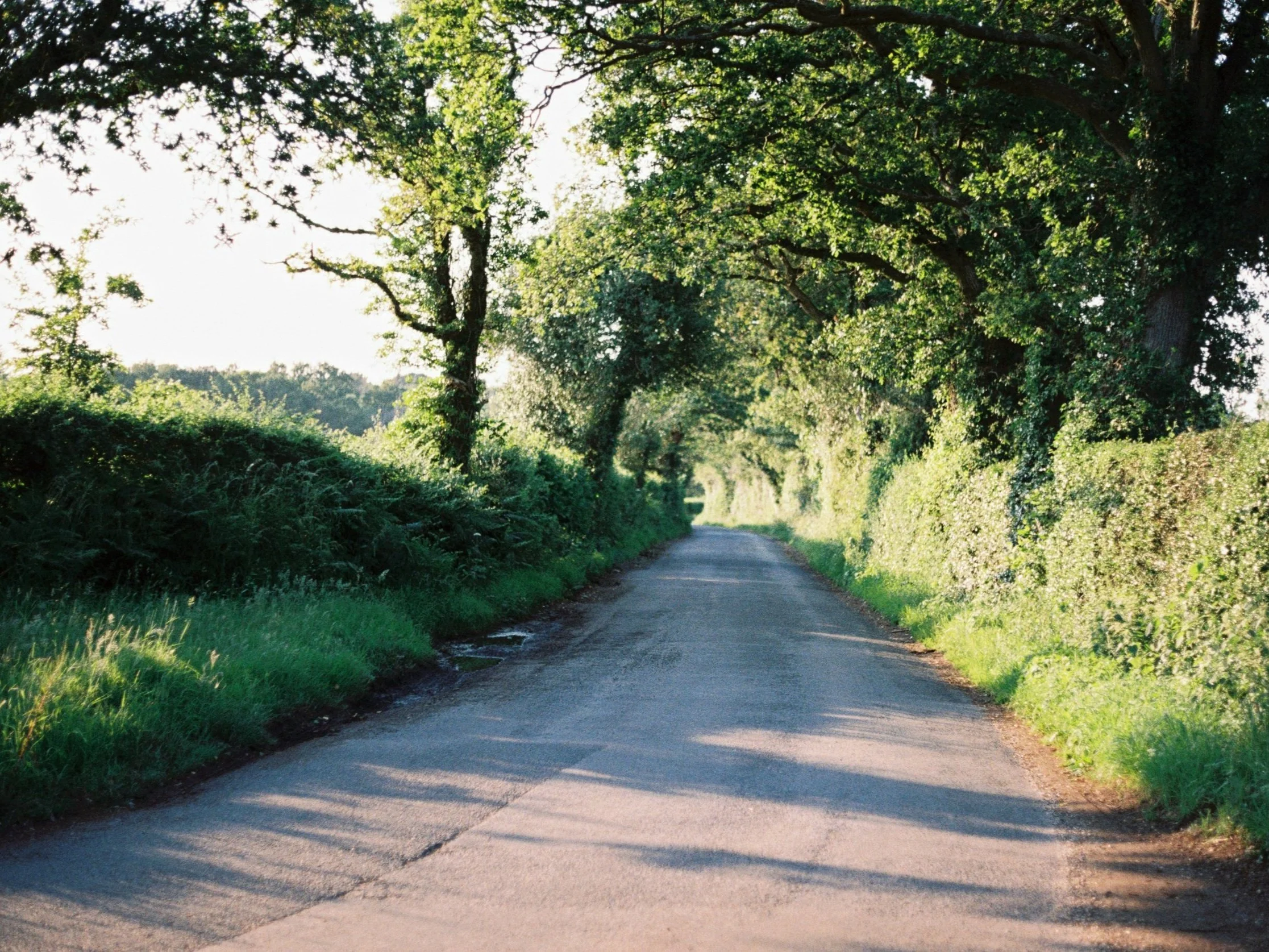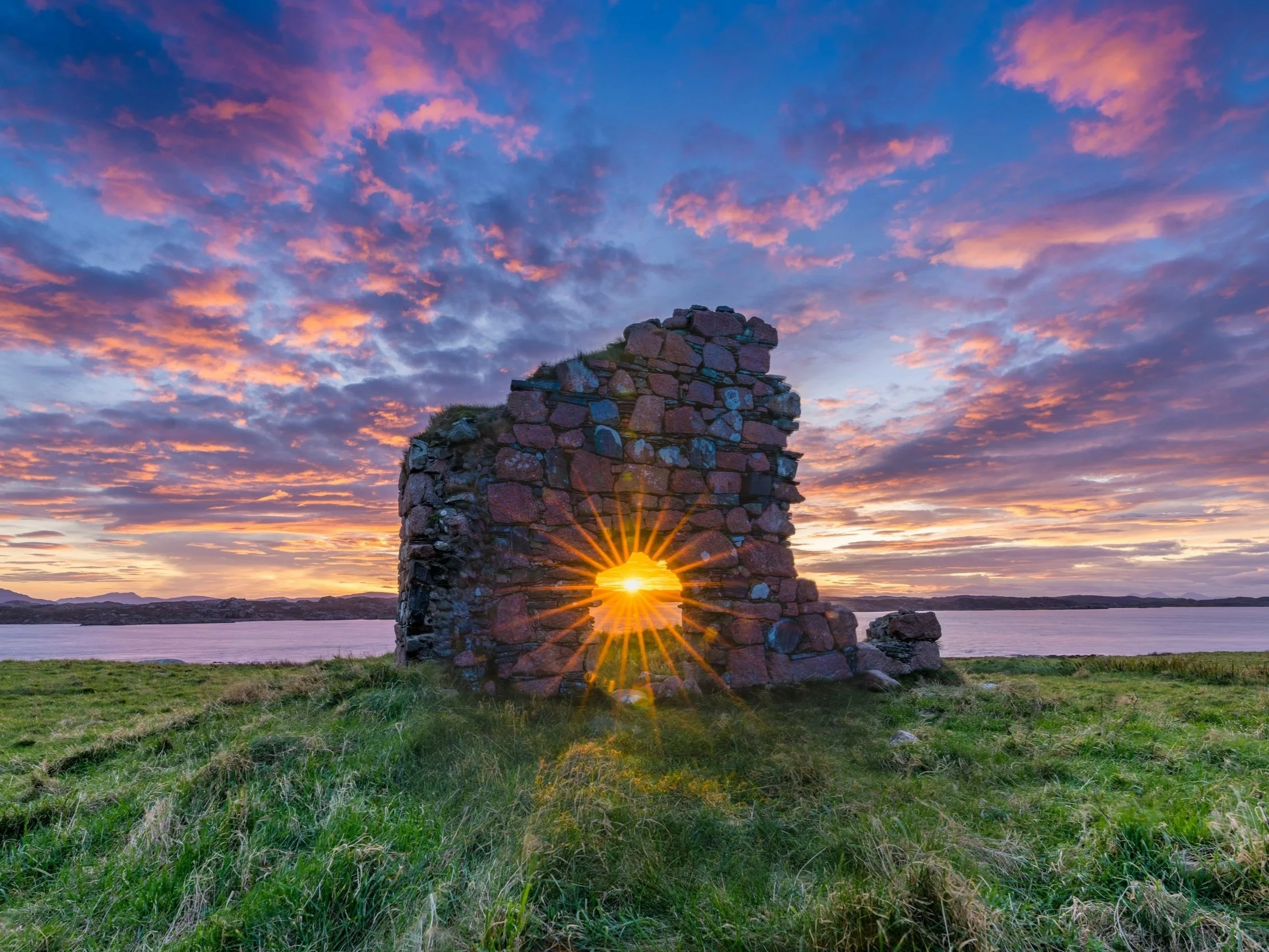Nature & folklore: an interwoven legacy in Ireland
Storm clouds gather over Poulnabrone Dolmen in County Clare — a neolithic portal tomb where Irish history and folklore converge.
Where land and lore entwine
You do not simply walk through Ireland. You enter it — as one might a myth, or a memory that belongs not just to the self but to the land itself. Its moss-draped oaks and bog-sunk meadows seem to remember.
A vast, ancient tree stands in misty light, its moss-laden branches twisting through the forest air. Soft gold filters through the leaves, touching the green undergrowth with quiet warmth.
They remember things you never lived, stories you never heard — but that somehow live in you.
In Ireland, folklore and nature are not companions; they are kin. Intertwined like ivy through stone, the two have grown together over millennia, each feeding the other. The ancient Celts who once called this island home did not separate spirit from soil. For them, a grove was not just trees, but threshold — a place where the worlds brushed and blurred. Rivers held voices. Hills bore the weight of gods. The wind itself might carry a message, if you listened just right.
This old way of seeing has never quite left the land. It lingers in tales whispered at kitchen tables, in roadside shrines to trees too sacred to fell, in the way fog hangs low over the peatlands like a secret not ready to be told. Even today, long after Christianity swept through and modernity paved its roads, Ireland holds space for the unseen — for that which science cannot measure but the soul still feels.
And perhaps nowhere is this more visible than in the rich folklore that lives on in Ireland’s forests, lakes, and hills. Here, the mythic coexists with the mundane. One may see a patch of hawthorn trees and know — without needing proof — that they are not to be disturbed, for the fair folk may dwell beneath. One may pass a field and recall that a leprechaun once buried gold there, or that the wind’s cry last night was not the weather, but the wail of a banshee.
To understand Irish folklore is to enter a landscape alive with memory — not only human, but ecological. It is a realm where land is not backdrop but character; not mute earth, but enchanted host.
The green veil of mischief and mourning
Ireland’s folklore is no gentle lullaby. It is laughter in the hedgerows and grief in the gale — a chorus of voices, both playful and prophetic. At its heart are two figures, as emblematic as they are enigmatic: the leprechaun and the banshee. One dances through the twilight fields with a sly grin; the other keens beneath moonlight for those about to cross the threshold into death.
Let us begin with the leprechaun.
Contrary to commercial caricature, these are not mere mascots of cereal boxes and tourist trinkets. In older tales, the leprechaun — leipreachán, from Old Irish luchorpán, meaning “small body” — is a solitary cobbler of fairy shoes, a creature of craft and cunning. He is said to dwell deep within the hills or in hidden hollows among the hawthorn groves, places so soaked in enchantment that to disturb them is to court misfortune.
The leprechaun embodies nature’s sly intelligence, its mischief and mystery. He guards his gold not for greed, but for the game — a reminder that the treasures of the land are not handed over easily. One must earn them, outwit them, sometimes lose one’s way entirely before finding what one truly seeks. His stories are riddles, puzzles of the landscape, cautionary tales of those who chased the rainbow and returned empty-handed — or not at all.
But if the leprechaun represents nature’s clever, capricious side, the banshee is its mourner — the weaver of sorrow into wind.
Bean sídhe, she is called — “woman of the sídhe,” the mounds that dot the Irish countryside, believed to be portals to the Otherworld. She is no mere ghost, but an ancestral spirit, her wail (caoineadh) a lament not just for the dead, but for the dying of older ways, older worlds. Her cry has been heard in counties from Donegal to Kerry, a bone-deep sound that chills even the most skeptical hearts.
The banshee does not kill. She warns. She watches. And in her we see nature’s raw empathy — a grief that cannot be soothed. Her legend reminds us that the wild is not always benign, but it is always aware. That the land notices our passing, and sometimes, mourns us.
Together, the leprechaun and the banshee form twin faces of the Irish imagination: mirth and mourning, trickery and truth, delight and dread. Both are guardians, in their own way. Both speak of a world where the natural and the numinous are stitched together with green thread.
They teach us to walk the land with humility. To listen before we speak. To respect what we cannot see — and what we cannot explain.
A quiet trail meanders through a native woodland carpeted in bluebells, where dappled light and fallen branches hint at the forest’s slow, sacred time.
The forest watches and the lake speaks
There are forests in Ireland where silence speaks louder than song. Trees lean in close, roots entangle like thoughts too old to unravel, and the very air feels watchful — not hostile, but aware. You sense that you are not alone. And perhaps you never were.
These woods are more than ecosystems; they are archives. Living libraries of story, where bark remembers and moss is the keeper of dreams. Among them lies the Doirí Beaga — the “Little Oakwoods” — a secluded forest in County Sligo, said to be thick with faerie presence. The trees here do not simply grow; they guard. The place is a threshold — part waking, part dream — where people have gone missing, or returned touched by something otherworldly, changed in ways they can’t explain.
In such places, landscape and folklore fold into one another. The forest is not just the setting of the story, but the story itself.
Irish lakes hold their own lore, too. Some mirror the sky, others the soul. Dark waters reflect more than clouds — they reflect what we fear, what we long for. Lough Gur in County Limerick is one such place: a liminal lake said to be the entrance to a hidden realm. On certain nights, it’s whispered, a phantom city rises from its depths, shimmering and soundless before vanishing again beneath the water’s skin.
These are not just stories born of boredom or whimsy. They are rooted in something older than language — a way of seeing the world as alive, as layered, as sacred.
In Irish folklore, the haunted and the hallowed often share the same ground. A grove might be cursed — or consecrated. A lake may lure — or protect. These contradictions are not meant to be resolved, but revered. For in the overlapping of reverence and fear lies the true magic of the land.
This tradition echoes ancient Celtic cosmology, where every element — tree, stone, stream — pulsed with presence. Spirits inhabited the land, not above it but within it. To cut a tree was to risk angering its guardian. To drain a bog was to stir what slept beneath. The natural world was not passive matter to be tamed, but a community to which one belonged — and owed respect.
These old beliefs still shape how the Irish relate to place. Even now, it’s not uncommon for a motorway project to be rerouted around a lone hawthorn tree, lest it disturb a faerie path. Rational? Perhaps not. But reverent? Absolutely. And in that reverence lies a form of wisdom we’ve nearly forgotten.
Where asphalt winds through green silence, the old trees stand undisturbed — a quiet truce between wild roots and human roads.
The fire festivals and the circle of the year
In the dark, a fire rises and people gather — a ritual flare where myth, memory, and flame speak to the forest beyond.
The Irish year is not a straight line, but a circle — one drawn in flame and fog, in harvest and hearth. Its rhythm beats in the turning of the sun, the greening of shoots, the decay of leaves, and the hush of snow. Time is not just counted here; it is lived, storied, sanctified. And at the heart of this sacred cycle lie the fire festivals: Bealtaine, Lughnasadh, Samhain, and Imbolc — quarter-points of light and shadow that shaped not only agricultural life, but spiritual life.
To mark these days was to honour not just the seasons, but the spirits who moved with them.
Bealtaine, celebrated at the start of May, welcomed the light half of the year — the season of growth, warmth, and openness. Bonfires were lit across the hills to protect against evil and disease, to summon fertility for crops and cattle. People would drive their herds between twin fires for blessing, their shadows cast in the orange flicker said to shield them from harm.
It was a time when the boundary between worlds grew thin. Faeries, long dormant through winter, stirred again — mischievous, vibrant, watching. Flowers were gathered not just for beauty, but to guard doorways, wells, and children. The land, once again, was alive and awake. And one treated it with both gratitude and caution.
Samhain, by contrast, ushered in the dark. Celebrated at the end of October, it was the Celtic new year — a liminal threshold when the veil between the living and the dead was thinnest. Fires were kindled to keep the cold and spirits at bay. People wore disguises not to celebrate, but to survive — to confuse the wandering souls and keep the fae from stealing them away.
It was a time of endings, of accounting — not only of harvests, but of what had been lost and what might still be carried forward. Ghost stories were not mere entertainments but necessary rituals, ways of remembering what haunted us, and perhaps, making peace with it.
Each festival circled the year like a lantern in the dark. They were not mere markers of time, but conversations with nature — acknowledgements that we live in a world not governed by human time alone, but by cycles much older, much deeper.
In these rites we find a kind of ecological reverence: not just seasonal celebration, but spiritual symbiosis. The Celts — and later, the Irish who inherited their ways — did not pray above the land, but with it. They sang to the stones. They spoke to the trees. They listened to the wind and answered back with fire.
And though these rituals may now be diluted by time, renamed or repackaged for modern tastes, their essence endures — in the hearth, in the hedge, in the hand that plants with intention. The land still turns, and we still turn with it.
The living myth — memory, spirit, and the Irish landscape today
To speak of Irish folklore is not to speak of a past buried — it is to speak of something still breathing, still whispering beneath the hedgerows and stone walls, still shaping the contours of thought and place. Though the old gods have been renamed, though faerie paths now skirt housing estates, the pulse of the mythic endures. It lives in language, in custom, in the quiet reverence for land that persists even amidst asphalt and artificial light.
For many in Ireland today, the stories have not vanished; they have adapted. They move through schoolbooks and bedtime tales, yes — but also through activism, land stewardship, and the fierce protection of wild spaces. A grove may now be preserved not only because it shelters wildlife, but because it shelters memory — a collective understanding that the land is more than commodity. It is kin. It holds meaning, even mystery.
This deep-rooted connection between land and story is not only beautiful — it is necessary.
In a world increasingly dislocated from the natural, where monocultures replace meadows and sacred wells dry beneath concrete, Ireland offers a counterpoint. It reminds us that folklore is not escapism. It is engagement. It is how people once — and still — make sense of a world too vast to fully understand. A way of honouring the mystery, not mastering it.
Folklore carries ecological truths inside its metaphor. The banshee’s cry teaches us that death is not to be denied, but acknowledged. The leprechaun’s trickery warns us against greed and extraction. The spirits that haunt forests and lakes caution us to tread lightly, to look before we build, to listen before we cut. In this sense, Irish folklore is not merely superstition; it is a coded language of environmental ethics, a kind of ancestral science bound in story.
And so it is no surprise that modern environmental movements in Ireland sometimes echo these older forms of wisdom. Protestors tying ribbons to ancient trees. Locals refusing to bulldoze a faerie fort for a bypass. These acts are not quaint. They are continuity. They are resistance not just to ecological destruction, but to cultural amnesia — the forgetting of a worldview that once saw rivers as sacred and the night as full of voices.
In preserving these stories, we preserve a way of seeing. A way of being.
We remember that a tree is not just timber. It is presence.
That a field is not just potential profit. It is passage.
That a stone is not just in the way. It is witness.
And that we — for all our maps and machines — are still guests here, walking the same hills our ancestors once trod, whispering the same names into the wind, hoping to be heard.
Because in Ireland, to walk the land is to walk through a story. One that is not finished. One that does not belong to us alone.
Sunlight pours through a stone ruin on the Irish coast, a quiet reminder that spirit, memory, and myth still dwell in the land.
And in that unfinishedness lies a great gift — the chance to listen again, to remember again, and perhaps, to belong again.






